COURSE OUTLINE 39
- GENERAL
| SCHOOL | SOCIAL POLITICAL AND ECONOMIC SCIENCES | ||||
| DEPARTMENT | SOCIAL POLICY | ||||
| LEVEL OF STUDIES | LEVEL 6 | ||||
| COURSE CODE | 39 | SEMESTER | 1st & 3rt | ||
| COURSE TITLE | Migration and Migration Policy | ||||
| TEACHING ACTIVITIES If the ECTS Credits are distributed in distinct parts of the course e.g. lectures, labs etc. If the ECTS Credits are awarded to the whole course, then please indicate the teaching hours per week and the corresponding ECTS Credits. |
TEACHINGHOURSPERWEEK | ECTSCREDITS | |||
| 3 | 6 | ||||
| Please, add lines if necessary. Teaching methods and organization of the course are described in section 4. | |||||
| COURSE TYPE
Background, General Knowledge, Scientific Area, Skill Development |
Scientific Area | ||||
| PREREQUISITES:
|
No | ||||
| TEACHING & EXAMINATION LANGUAGE: | Greek | ||||
| COURSE OFFERED TO ERASMUS STUDENTS: | Yes | ||||
| COURSE URL: | |||||
- LEARNING OUTCOMES
| Learning Outcomes | ||
| Please describe the learning outcomes of the course: Knowledge, skills and abilities acquired after the successful completion of the course. | ||
| At the completion of the course students should be able to:
Analyse and evaluate migration as a multi-dimensional phenomenon. Identify and distinguish migratory movements. Analyse the theoretical and empirical literature concerning the constituents of economic migration, its key historical milestones at European level and its socio-economic consequences in the origin countries, in the receiving countries and in migrants themselves. Describe and evaluate the migration policies of Greece and EU, their mutual interdependence, their connection to the wider historical and socio-economic context, as well as the effectiveness of these policies. Discuss on moral issues raised by the migration phenomenon in order to cultivate tolerance and reduce discrimination. Suggest ways to manage migration issues.
|
||
| General Skills | ||
| Name the desirable general skills upon successful completion of the module | ||
| Search, analysis and synthesis of data and information,
ICT Use Adaptation to new situations Decision making Autonomous work Teamwork Working in an international environment Working in an interdisciplinary environment Production of new research ideas |
Search, analysis and synthesis of data and information,
ICT Use Adaptation to new situations Decision making Autonomous work Teamwork Working in an international environment Working in an interdisciplinary environment Production of new research ideas |
|
| Search, analysis and synthesis of data and information, Decision making, Autonomous work, Teamwork, Critical thinking, Promoting free, creative and inductive reasoning, Equity and Inclusion, Respecting cultural diversity, Developing moral judgement and moral sentiments.
|
||
- Course Content
| The course material is divided into 13 weeks, the content of which is as follows:
|
- LEARNING & TEACHING METHODS – EVALUATION
| TEACHING METHOD Face to face, Distance learning, etc. |
Face to face | |||||||||||||
| USE OF INFORMATION & COMMUNICATIONS TECHNOLOGY (ICT) Use of ICT in Teaching, in Laboratory Education, in Communication with students |
International statistical databases, the department’s e-class platform for posting teaching materials and announcements and for communication with students. Presentation software (e.g. ppt). | |||||||||||||
| TEACHING ORGANIZATION
The ways and methods of teaching are described in detail. Lectures, Seminars, Laboratory Exercise, Field Exercise, Bibliographic research & analysis, Tutoring, Internship (Placement), Clinical Exercise, Art Workshop, Interactive learning, Study visits, Study / creation, project, creation, project. Etc.
The supervised and unsupervised workload per activity is indicated here, so that total workload per semester complies to ECTS standards. |
|
|||||||||||||
| STUDENT EVALUATION
Description of the evaluation process
Assessment Language, Assessment Methods, Formative or Concluding, Multiple Choice Test, Short Answer Questions, Essay Development Questions, Problem Solving, Written Assignment, Essay / Report, Oral Exam, Presentation in audience, Laboratory Report,Clinical examination of a patient,Artistic interpretation, Other/Others
Please indicate all relevant information about the course assessment and how students are informed |
Either individual work (30%) + Final exam (written or oral during the June exam) (70%)
Or final exam (written or oral during the June exam) (100%)
|
- SUGGESTED BIBLIOGRAPHY
| Labrianidis, L., και Sykas, T. (2017). Why High School Students Aspire to Emigrate: Evidence from Greece. Journal of International Migration and Integration, 18, 107-130.
Βεργέτη, Μ. (2016). Παλιννόστηση και Κοινωνικός Αποκλεισμός. Θεσσαλονίκη: Εκδόσεις Κυριακίδη. Δαμανάκης, Μ. Κωνσταντινίδης, Σ. Τάμης, Α. (Επιμ.). (2014). Νέα Μετανάστευση από και προς την Ελλάδα. Ρέθυμνο: Εκδόσεις Κέντρου Ερευνών & Μελετών (Κ.Ε.Μ.Ε.). Λαμπριανίδης Λ., και Συκάς Θ. (2021). Το φαινόμενο της Μετανάστευσης Υψηλής Ειδίκευσης: η διαρροή εγκεφάλων (brain drain) στην περίπτωση της Ελλάδας. Αθήνα: ΕΑΠ. Λαμπριανίδης, Λ. (2011). Επενδύοντας στη φυγή: Η διαρροή επιστημόνων από την Ελλάδα την εποχή της παγκοσμιοποίησης. Αθήνα: Κριτική. Ροντιέ, Κ. (2016). Μετανάστες και πρόσφυγες. Απαντήσεις σε αναποφάσιστους, ανήσυχους και επιφυλακτικούς. Αθήνα: Εκδόσεις του Εικοστού Πρώτου. Τριανταφυλλίδου, Α. Μαρούκης, Θ. (Επιμ). (2010). Η μετανάστευση στην Ελλάδα του 21ου αιώνα. Αθήνα: Εκδόσεις Κριτική. |
 Ο Πρόεδρος και τα μέλη του Διδακτικού Προσωπικού καλωσορίζουν τους νεοεισαχθέντες φοιτητές του Τμήματος.
Ο Πρόεδρος και τα μέλη του Διδακτικού Προσωπικού καλωσορίζουν τους νεοεισαχθέντες φοιτητές του Τμήματος.
